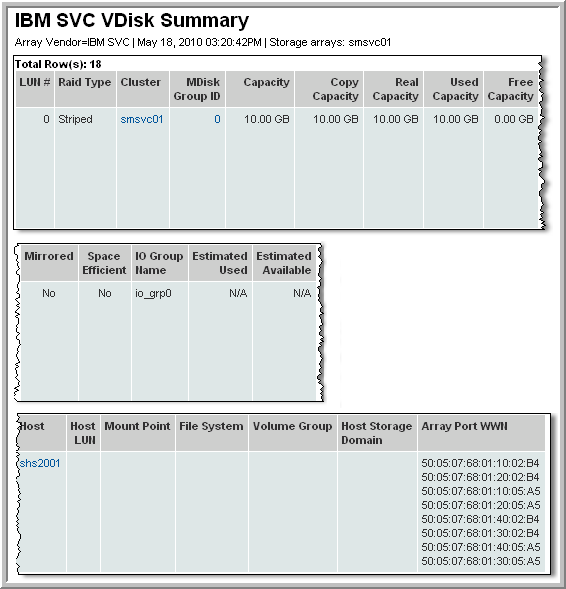IBM SVC VDisk Summary
Detail reports are related to a specific enterprise object, such as a backup job or SAN fabric. You can only access detail reports through a link presented in the context of a main report, providing additional information that augments the main report. Detail reports cannot be generated, customized, or saved, as they are specific to the report from which they were derived. Therefore, they will not be available in search results.
Use Quick search to find the main template, report or a dashboard by name. Search is case insensitive, supports partial entries, and will display a list of potential matches.
As you enter the template, dashboard or report name in the Quick Search field, up to 10 potential matches are displayed. If the result is shown, you can select and run it directly from the match list. You can also select All Items to display the full search results page and further filter your results.
You can use the Explorer tab to browse through the StorageConsole templates, dashboards and reports. The navigation pane displays templates organized by products along with user created, and system folders. The main report is located here:
Capacity Manager > Array Capacity & Utilization > Array Capacity & Utilization
Then, select IBM SVC arrays for the report scope.
Then, click on # VDisks or # VDisks Allocated to Hosts.
The following view is available when only IBM SVC arrays are selected for the report scope. In addition, several related reports narrow the list of LUNs in the report:
• IBM SVC VDisk Summary - Unallocated: Access this report from the Array Capacity & Utilization report by clicking on #VDisks Unallocated.
• IBM SVC VDisk Summary - Allocated: Access this report from the Array Capacity & Utilization report by clicking on #VDisks Allocated to Hosts.
To display IBM SVC LUNs, along with LUNs from other storage vendors, see the
LUN Utilization Summary.
LUN # | The LUN number |
RAID Type | SVC RAID Type: Striped, Mirrored |
Cluster | 2-8 nodes comprise a cluster; 2 nodes comprise an I/O group |
MDisk Group ID | The name of the MDisk group |
Capacity | Total VDisk (LUN) capacity |
Copy Capacity | Copy capacity includes mirrors |
Real Capacity | Allocated VDisk capacity; the capacity that is available to hosts |
Used Capacity | Amount of the allocated VDisk capacity (real capacity) that is used |
Free Capacity | Free = Capacity - Real Capacity |
Mirrored | Indicates if this LUN has a mirror |
Space Efficient | Indicates if this is a thin-provisioned LUN |
IO Group Name | The name of the I/O group to which this VDisk belongs |
Estimated Used | From the host’s perspective, the amount of storage used |
Estimated Available | From the host’s perspective, the amount of available storage |
Host | Hosts that have storage allocated from this LUN |
Host LUN | The name of the host to which storage from this LUN was allocated. Click on a host link to launch the Host Utilization Detail. |
Mount Point | Mount point of the filesystem |
Filesystem | The host’s filesystem or drive name to which the LUN maps. LUNs simply appear as disks to hosts. |
Volume Group | Volume group using storage from this LUN |
Host Storage Domain | A logical group of LUNs that can be accessed by multiple hosts through the same physical storage port, with each host accessing its unique LUN. For security purposes, LUN masking is also coupled with this capability. For Hitachi arrays, this is the multi‑hosted storage capability. |
Array Port WWN | The array port world-wide name |

